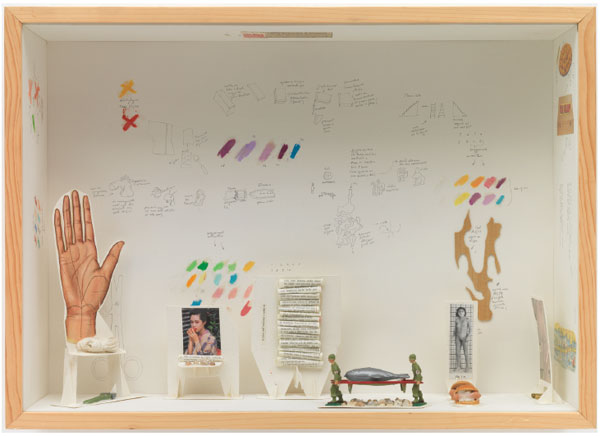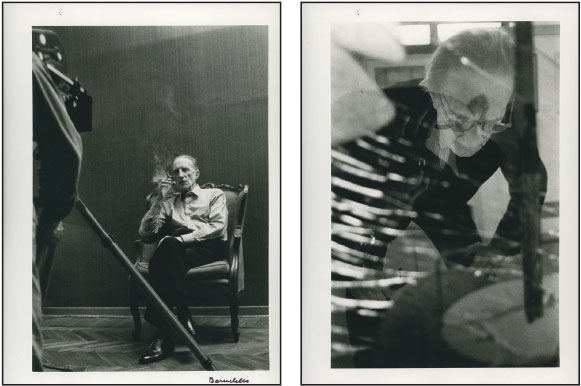Making art serve the mind
Updated: 2017-09-15 07:20
By Liana Cafolla(HK Edition)
|
|||||||
|
Gianfranco Baruchello’s signature work, Fire Island Story, is now showing at Hong Kong’s Massimo de Carlo gallery. |
An exhibition inspired by dialogues about art and its purpose between two leading creative minds from Europe - Gianfranco Baruchello and Marcel Duchamp - opens in HK tonight. Liana Cafolla has the details.
An unusual - and unusually complex - art exhibition opens in Hong Kong at the Massimo de Carlo Gallery in Central this evening. Entitled, Gianfranco Baruchello, Marcel Duchamp, the show features the works of two exceptional contemporary conceptual artists with intertwining sensibilities. The Italian Baruchello, a multimedia artist, is still active in his 90s. This is his first exhibition in Asia.
|
Gianfranco Baruchello would sometimes turn Marcel Duchamp, his friend and inspiration, into the subject of his art. Photos provided to China Daily |
Baruchello met the renowned French artist, sculptor and chess-player Marcel Duchamp in 1962. The bond between them was immediate and strong, sustained at both personal and professional levels until Duchamp's death in 1968. The duo broke fresh ground by challenging earlier notions about what constitutes art and how it could be communicated.
The exhibition consists of about 12 pieces by Baruchello and six by Duchamp. Baruchello's creations are his representative works, selected from across more than six decades of his artistic career. Together the exhibits help illuminate how the two artists responded to each other's ideas, which would sometimes trigger off a creative spark in either or both.
While the show features works by both artists, the spotlight is firmly on Baruchello. At first glance, his works - much of it child-like drawings, cut-outs and montages, sometimes with arrows indicating a progression or chain of thoughts - appear remarkably simple, but a closer inspection reveals their depth. For example, in one of Baruchello's creations, called Fire Island Story, a vitrine made in 2009, the small handmade objects and drawings represent thoughts and feelings as they change over time. As a reviewer wrote in the frieze magazine, "Viewers do not so much look at a Baruchello painting as travel through it, armed with infinite patience and, ideally, a large magnifying glass." Duchamp had once said that Baruchello's works should be viewed "from close up, over the course of an hour".
Duchamp, recognized as a major influence on 20th century art, was a noted pioneer of Dada, an art movement that questioned accepted ideas of what art ought to be, and also a practitioner of Cubism and conceptual art. He wanted "to put art back in the service of the mind" rather than let it remain only as a feast for the eyes.
Born in 1887, Duchamp was already well-known in the international art world before Baruchello was born. He was equally famous for his avant garde thinking about art as he was for his paintings. For example, he maintained that art needn't be created from scratch. By 1913 he was causing a stir with his "readymades" - everyday objects that he controversially presented as works of art. His Bicycle Wheel - a single bicycle wheel fitted into a wooden stool - is a celebrated example from among these.
Baruchello was born in 1924, in Livorno, Italy, almost 35 years after Duchamp. He started gaining recognition in the 1960s for his involvement in the pop art movement. He was also part of Arte Povera, or poor art, an anti-establishment art movement based in Italy.
"Baruchello broke through with a completely different language, one that was in some way criticizing the old art and commercial system a little bit and, on the other side, wanted to find its own way of existing and expressing," explains Claudia Albertini, the exhibition curator and gallery director.
Since then Baruchello has worked in different media - painting, sculpture, land art, installations and video. For seven years in the 1970s, he worked on a farm, exploring the links between farming and art. Later he would set up an art foundation, Fondazione Baruchello, on the same site, describing it as "an institution dedicated to experimenting with both ideas and projects for art - a sort of think tank for the contemporary world".
Of art and history
Hong Kong arts commentator and photographer Caroline Chiu says the show is indeed something special. "It's about a 90-something-year old artist with a huge artistic heritage, and this is his first show in Asia," she says, adding it is unusual to have an exhibition based entirely on the exchange of ideas between two artists.
The value of this show won't be lost on a sophisticated Hong Kong audience, she says. "People in Hong Kong are not just interested in art. They're also interested in the history of ideas."
"The show is visually very attractive and people can get very curious, but I think it will take a little bit of time to really understand the thinking behind it," feels Albertini. Baruchello, she says, "is accessible, but maybe he's not as easy to relate to as (those who practise) other (regular) forms of art. Nowadays, nonetheless, he is probably one of the most recognized Italian artists."
Also, it's uncommon in Hong Kong to be able to meet a working artist from Europe aged over 90, she notes.
The artist himself says the exhibition is designed to appeal to people who are "willing to look at images related to the oneiric and fairy-tale like works, rather than at ideologies and tendencies or at specific styles".
He is both excited and curious to find out how Hong Kong people will react to his work. "I cannot for now imagine the interpretation of my visual-mental language nor the stimuli that the occasion will inevitably offer me. The opportunity of showing in Asia, after having exhibited in many different parts of the world, is very desirable."
For those seeking to emulate his creative longevity, Baruchello's advice is simple: "Continue to understand the world, the others and ourselves through just one tool: art, which doesn't exhaust the curiosity and the desire to think and do. This has been since the very beginning the ultimate goal of art."
(HK Edition 09/15/2017 page10)

